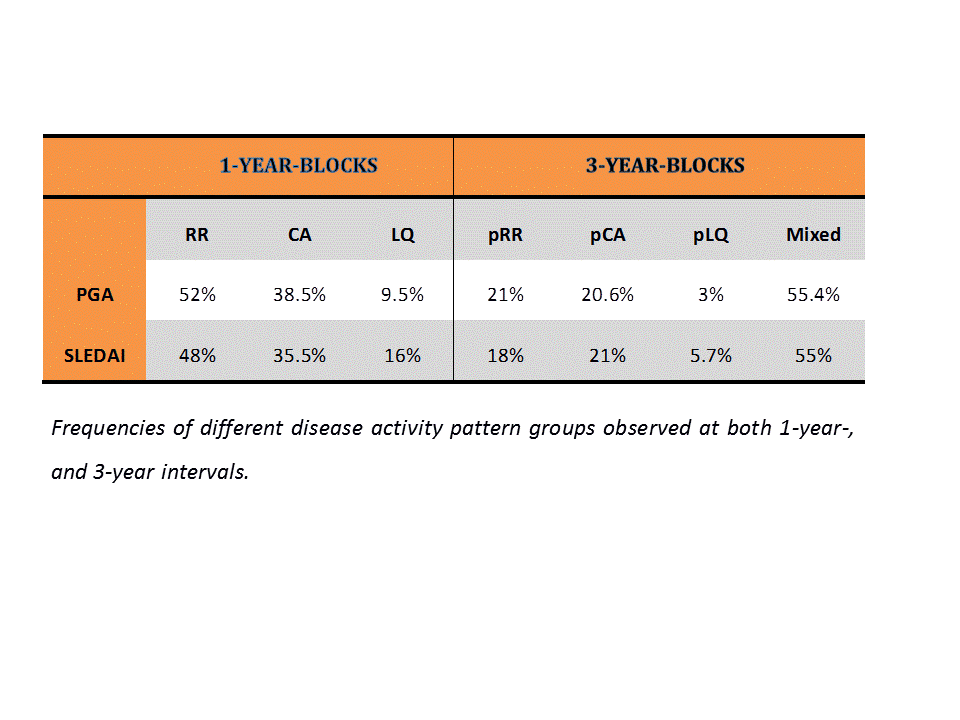Session Information
Date: Tuesday, November 10, 2015
Title: Systemic Lupus Erythematosus - Clinical Aspects and Treatment Poster Session III
Session Type: ACR Poster Session C
Session Time: 9:00AM-11:00AM
Background/Purpose: Systemic Lupus
Erythematosus (SLE) is a multi-systemic inflammatory disease, characterized by
an extreme variability of its expression, both between and within individuals,
over time. Overall disease activity is a predictor of both mortality and organ
damage. It is therefore important to understand the
burden of disease course over time among patients with SLE. We aimed to discern and describe SLE disease activity patterns over
time by analyzing data from the Hopkins Lupus Cohort.
Methods: Disease activity was retrospectively
studied in a cohort of 2386 SLE patients followed up quarterly for 1-28 yrs (10
367 person-yrs of F/U). SLE disease activity patterns were defined using 1)
Physician Global Assessment (PGA) and 2) SLE Disease Activity Index (SLEDAI), including
serology: Long Quiescent (LQ), SLEDAI/PGA=0 for 1 yr at all visits;
Relapsing-Remitting (RR), periods of disease activity (SLEDAI/PGA>0)
interspersed with periods of disease inactivity (SLEDAI/PGA=0) at 1 or more
visits during 1 yr; Chronic Active (CA), SLEDAI/PGA scores are >0 for 1 yr
at all visits. Disease activity at yearly intervals (“1-yr blocks”) was readily
classified into 1 of the 3 major patterns for each patient. The pattern in each
patient of 3 consecutive F/U years (“3-yr blocks”) was also determined:
Persistent Long Quiescent (pLQ), LQ pattern in each of the 3 yrs; Persistent
Remissing-Remitting (pRR), RR pattern in each of the 3 yrs; Persistent Chronic
Active (pCA), CA pattern in each of the 3 yrs; Mixed, at least 2 different
patterns during 3 consecutive yrs. The frequency of different pattern groups
(LQ, RR, CA) in each “1-yr-block” and pattern subgroups (pLQ, pRR, pCA, Mixed)
in each “3-yr-block” of F/U was examined.
Results: Three major patterns of SLE
disease activity were identified: LQ, RR, and CA. The RR pattern accounted for
the greatest proportion of F/U time for both the SLEDAI and PGA, representing
48% and 52% of total person-yrs, respectively. The CA pattern was the
second most frequent pattern observed. The least prevalent pattern was the LQ, indicating that 655 patients experience 1674
LQ “1-yr-blocks”, and 352 patients experience 981 LQ “1-yr-blocks”, using
SLEDAI and PGA, respectively. When
disease activity was defined within 3-yr intervals, the
Mixed pattern was the most common for both the SLEDAI and PGA, representing 55%
of total “3-yr blocks”. The pRR and pCA patterns were intermediate and similar in frequency. The pLQ was the least frequent subgroup. The SLEDAI was more likely
to depict the LQ pattern than was the PGA.
Conclusion: In this large cohort, the
three major patterns of SLE disease activity as originally identified by Barr
et al. were confirmed. In the present study, the RR pattern appeared to be the
most prevalent pattern type. Long quiescence was achieved in a subset of patients.
Over a 3-yr perspective almost half the patient maintained their disease
activity pattern.
To cite this abstract in AMA style:
Györi N, Chatzidionysiou K, Magder LS, van Vollenhoven RF, Petri M. Disease Activity Patterns over Time in Patients with SLE – a Retrospective Descriptive Analysis of the Hopkins Lupus Cohort [abstract]. Arthritis Rheumatol. 2015; 67 (suppl 10). https://acrabstracts.org/abstract/disease-activity-patterns-over-time-in-patients-with-sle-a-retrospective-descriptive-analysis-of-the-hopkins-lupus-cohort/. Accessed .« Back to 2015 ACR/ARHP Annual Meeting
ACR Meeting Abstracts - https://acrabstracts.org/abstract/disease-activity-patterns-over-time-in-patients-with-sle-a-retrospective-descriptive-analysis-of-the-hopkins-lupus-cohort/

